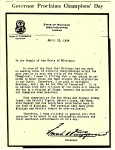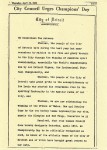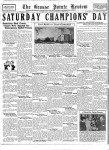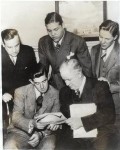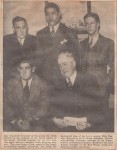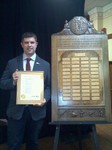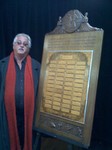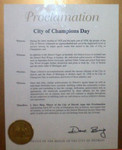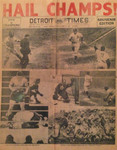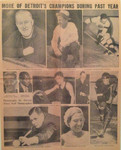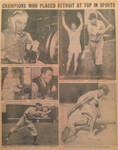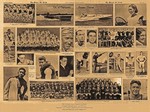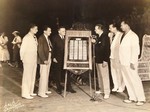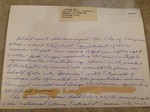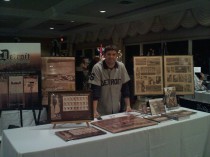City of Champion &
Champions Day Museum
Welcome to the City of Champions Museum. The images that you will see on this page represent some of the rarest and most important pieces of Detroit Sports history in existence. Over the past five years, Diomedea Publishing has been collecting this memorabilia in the hopes of giving it a permanent home at our future headquarters. It is also a page for promoting news and information on the developments of Champions Day.
Original Champions Day Proclamations
Champions Day Wikipedia Page:
Diomedea Publishing is indebted to Christopher Boerma for his work in creating the "Champions Day" Wikipedia page. This page began with merely a handful of photos and references from Charles' first City of Champions book in 2010. Through 2016 it has grown into an incredibly important reference. As newspapers from across the country go digital, their 1936 articles which mention "Champions Day" attach themselves to the page and unknown details regularly emerge seemingly out of nowhere.
Champions Day Updates
(Numerous other updates on bottom of Champions Day Wikipedia page)
4/18/12: Champions Day is Back!! After 3 years of effort, Diomedea Publishing is proud to announce that Mayor Dave Bing has signed the paper work effectively reinstating Champions Day as an official, annual event to be recognized in the City of Detroit. At the Detroit Historical Museum on April 18th 2012 this document was read by deputy mayor Kirk Lewis.
4/21 & 4/22/12: A public celebration was held at the Made in Michigan art store: Art-Is-In Market inside 12 Oaks mall (Novi, MI). The event featured original newspapers, banners and discussions about all things related to the Detroit City of Champions season.
4/17/14 - 4/26/14: On April 17th 2014 a week long, public celebration of Champions Day begins at McShanes Irish Pub (1460 Michigan Ave., Detroit). The night of April 17th will be marked by a few words from City of Champions author, Charles C. Avison, followed by a showing of the 1935 baseball movie "Play Ball!" A schedule of events will be announced for the rest of the week and will include athletic events on the grounds of old Tiger Stadium as well as a series of tailgate parties in the parking lots surrounding Comerica Park.
Gallery of Champions Day Artifacts
Champions Day: By Charles C Avison
Detroit, Michigan. Saturday, April 18th 1936. 7 o’clock. The hour had finally arrived. Every preparation had been made at the Masonic Temple for this event. The crystal chandeliers were sparkling, silverware shined, cloth napkins all neatly folded and arrayed, food, wine and beer prepared, tables and chairs to seat 800. The sedans and limousines had been pulling up all afternoon as the guests arrived for a celebration unlike any the World had ever seen.
While the United States had been struggling for any excitement amid the misery of the Great Depression, one City alone had reason to celebrate. This party at the Masonic Temple would be the culmination of an incredible sports season and celebrate the establishment of a new holiday declared by the Governor of Michigan and City Council of Detroit---Champions Day.
This formal celebration banquet would not be the first for Detroit during this year. In fact, this season (1935-1936) had witnessed four major banquets already. Joe Louis, had received a testimonial dinner from the City as a result of his remarkable rise from unknown fighter to international superstar and “A.P. Most Outstanding Athlete of 1935.” As well, the Detroit Tigers, Lions and Red Wings had all received celebratory dinners after each had won their first championships during this same season.
However, this banquet was different, it would be hailed as: “The Greatest Gathering of Champions Under a Single Roof;” and at this banquet all of the Champions from this season would be in attendance. They were here to celebrate the creation of a new title that combined the accomplishments of all into a single ideal. They were here to celebrate how Detroit had become, “The City of Champions.”
At this moment, a distinguished looking older gentleman with white hair appeared. All who saw him knew instantly who he was; for it was he who had drawn the attention of crowds up to a million people along the Detroit River, year after year. It was he who had won international renown for Detroit on that very same River. It was in fact, Commodore Garfield Arthur Wood, or Gar as he was affectionately known—“The Gray Fox of the Algonac.”
His 20 year career and his role in the evolution of speed on water would have been well understood by all who saw him. It was this man who had risked his reputation, personal fortune, and even his life to ensure that Detroit retained the most prestigious and coveted trophy in the World—the Harmsworth Trophy. Winning the trophy in 1920 from the English off the coast of the Isle of Wight, he and his boat the Miss America I had set the World Record for speed on water (61.51 mph). Several boats and near death experiences later, he and Detroit still retained the trophy after 9 successive title defenses. In fact, his race on the St. Clair River in 1933 in his boat the Miss America X had so demoralized the rest of the World competition; that no one had dared challenge him again (124.86 mph). He still retained the Harmsworth as he strode into the banquet confident in the knowledge that no one had ever beaten him in Harmsworth competition, yet at this moment he could not know--that no one ever would.
After Gar Wood was introduced by the Master of Ceremonies (Bud Shaver, Sports Editor, Detroit Times newspaper) all eyes and ears (the event was broadcast via radio station WXYZ) were directed to where the Guest of Honor was being introduced. This young boxer had so galvanized the sports world in the previous 14 months that he literally needed no introduction. Yet, this was his moment and in his usual humble way Joe Louis smiled and waved to the crowd as Bud Shaver praised him as a “fighter and as a sportsman”. He was roundly cheered by all in the room and the applause was much deserved, because his achievements during this season were the very stuff that legends are made from. In a whirlwind 14 month time frame, Joe Louis had fought his first 24 fights and won them all. His display inside the ring was unmatched, with only four of his fights won by judge’s decision and many of his gruesome knockouts leaving his victims in a ghastly condition. He had married on the day of his most important fight of 1935, for extra motivation for winning quickly (to get on to his honeymoon) and it was his victim on this day (9/25/35)—Max Baer, who said, “fear, is looking across the ring at Joe Louis and knowing he wants to go home early.” It was Joe Louis who captured the hearts and minds of Depression era people, especially in the African American communities across Detroit/United States. In the midst of the Depression these communities had been looking for any reason to celebrate—and in this season their Champion had arrived.
As Joe Louis sat down to eat his dinner, he picked up the commemorative newspaper issued by the Detroit Times specifically for this event. His eyes most assuredly drifted over the photos until they stopped at his favorite baseball team, the Detroit Tigers and his favorite player, Gerald “Gee” Walker. It was for this team that he had rushed home after his honeymoon in order to watch them play in the 1935 World Series.
His memories of the event certainly were refreshed as he looked up from his newspaper, to listen as Bud Shaver passed the microphone to the first speaker of the night; Mickey Cochrane-coach, catcher, heart and soul of the Detroit Tigers. Cochrane stood “to the accompaniment of a mighty reception,” and introduced the Tiger Players, one after another to the thundering applause of all in attendance; each a legend in his own time: Lynwood “Schoolboy” Rowe, Tommy “Lion Heart” Bridges, Elden “Big Six” Auker, Alvin “General” Crowder, Henry “Hammering Hank” Greenberg, Charlie “The Fowlerville Flash” Gehringer, Leon “Goose” Goslin, Herman “Flea” Clifton, Joyner “Jo-Jo” White, William “Bill” Rogell and the list would go on until Cochrane reached the one sad note. He referenced the one man who most assuredly would have been at this celebration—Frank Navin, but had died only five weeks after watching the team he built win their first World Series. “We’ll be in there swinging for another Championship, I’ve got a tough job in attempting to carry on without Mr. Frank Navin. But I hope the fans will stick with me.” From the riotous cheering which followed his final remark, it was apparent that they would.
The Detroit Lions next took their bows as Shaver introduced them. Captain Earl “Dutch” Clark, Leroy “Ace” Gutowsky, Grover “Ox” Emerson, George “Tarzan” Christensen, Ernie Caddel, Clare Randolph, Glen Presnell, Bill Shepherd, Tom Hupke and all the rest who had brought the 1st NFL Championship to Detroit in only their 2nd season. The crowd roared approval when Potsy Clark (Lions head coach) stood and declared his aggregation “the greatest football team ever assembled.”
Next, the microphone was passed to Jack Adams, coach and general manager of the Red Wings. Despite the continuous cheering of the fans up to this point, somehow the already raw clapping hands and hoarse throats created an even louder cacophony of noise. It was well that they did, as Adams had a much more daunting task in giving his speech. For not only did he have to introduce his own Stanley Cup winning team, he also had to introduce the minor league Detroit Olympics; who had won their Championship (Teddy Oke trophy) as well! The list of athletes on these teams read like a who’s who of hockey legends; (Captain) Doug Young, Ebbie Goodfellow, Larry Aurie, Herbie Lewis, Ralph “Scotty” Bowman, Bucko “the Socko” McDonald, Syd Howe, and the brothers Hec and Wally Kilrea. Modere “Mud” Bruneteau, John Sorrell, and the goalie Normie Smith were also among the many others who had laced up for the Red Wings’ first Championship. Adams would go on to praise the contributions of the Wings’ owner, James Norris who had saved the franchise when so many teams other teams during the Depression had folded and who had done so much toward bringing Detroit its first Stanley Cup.
But the celebration was far from over. Bud Shaver’s mission now, was to introduce the many other Championship athletes from this season. There! Is Walter Hagen, captain of the victorious U.S. Ryder Cup team. Here! Is Eddie “the Midnight Express” Tolan, gold medalist and 1935 sprinting champion. There! Dick Degener, 1935 Diving Champion and “Fred Astaire of the sports world.” Here! Esther Politzer and Constance O’Donovan, 1935 Womens Tennis Champions. The roll call of champions would last into the evening, as many other teams and athletes were introduced; including the 1935: Bowling Champions (Stroh’s), Softball Champions (Dixie Oils), Billiards Champion (Jake Ankrom), Swimming Champions (Detroit Athletic Club), Skeet shooting (Henry B. Joy), Badminton (Walter Kramer). But last and certainly not least among the many others to be introduced, was Newell Banks the 1935 World Checkers Champion!
Throughout the course of the speeches on this night, one common theme resonated in all who spoke. The appreciation to the fans of Detroit for their incredible support. In seeking to understand how such an almost miraculous season could have possibly taken place, an article appeared in The Detroit News only a few days before (April 13th 1936) by Harry Leduc. In this article, the question was posed “upon what meat does our City feed upon that it has grown so great?” The answer to this question would have been apparent to all in attendance on that night. For in the midst of great hardship, the incredible is absolutely possible. In fact, in the midst of hardship is when people have the chance to show what they are really made of. In this season, the fans had rallied around their teams like no city before or since; one example is the one million fan attendance of the Tigers 1935 season, a quarter of the total attendance of Major League Baseball.
In essence, Leduc’s article pointed to the idea that because Detroit was the hardest hit City in the Depression; they needed celebration and excitement. That the people of Detroit literally willed their teams to victory; proved that anything is possible if you allow yourself to believe that it can or even will happen.
The rest of this night on Champions Day 1936 was spent in merrymaking; with athletes and fans trading stories and laughing. Photos were taken in a myriad of situations; Tigers shaking hands with Lions, Red Wings, Gar Wood and Joe Louis. Mickey Cochrane who had scored the winning run even posed with Pete Kelly who had scored the winning goal for the Red Wings. It was a night unlike any other and one most definitely worthy of the event; for this night marked the beginning of the “modern age” of Michigan athletics. On this night, Detroit Tiger Fans celebrated the transition to becoming fans of all Detroit Sports. As a writer (Bob Murphy, Detroit Times) said in an article about this evening “It was a stirring occasion and one that Detroit fans can never forget.”
The people who celebrated at this event would have known how much they had achieved in this season; yet they could not possibly know the far reaching impact that their accomplishments would have on future generations.
In winning their first Championships, they had created a foundation for all future successes to be built upon. In the cases of Detroit football and hockey, both had been struggling up until this season (the Lions were the fourth attempt at an NFL team, the Red Wings being the third name of the franchise) but in this season both would be stabilized and their futures in the City secured. In creating the title “City of Champions,” they had created an identity and an aura about the uniqueness of Detroit Sports which would only grow with each generation.
Yet, one thing must not be overlooked. The fact that these people lived through the misery of the Great Depression and fought through World War II; well are they called America’s Greatest Generation. They set a tremendous precedent for struggling through adversity which should never be forgotten, also, this season may represent an idea for overcoming present day struggles. An excellent example to the important reason for studying history; that of the idea, “if we learn what our ancestors did right, we can repeat and even add onto their successes.” In this case the creation of a massive infusion of Civic Pride. In short; Hope. Hope that if they could fight through their problems then so will people in the present and future.
In the modern world of sports enthusiasm, there may be no more perfect beacon to draw attention towards these concepts. To create a rallying cry (City of Champions) for modern day people and a reputation for them to live up to. There once was a dream that Detroit would become one of the great cities on earth. To “set the bar high” in the pursuit of this excellence by using their story as a reminder offers a tremendous opportunity to get “back on track” and give a specific date (i.e. 75th anniversary, April 18th 2011) for the beginning of a modern day Detroit renaissance. Of course these ideas are just that, without vigorous effort and belief that it can happen, this story will remain just another trivia question for stumping bar patrons. The story of these people has already been chronicled but the use of it for the modern day benefit could serve as a powerful chapter in the story of Detroit which is yet to be written.
One thing is certain, however, that as the people at home turned off their radios to go to sleep and the last sedan left the Masonic Temple; they could smile and know that they had left their children a great many gifts. The gift of pride in knowing that they were unique in the annals of sport (no city has since won three major championships in the same season) the gift of a City that had risen to the center of culture and arts in the region, the gift of a holiday should future generations ever need reason to celebrate, the gift of hope should they ever be struggling, and the legacy of heritage-that their City was then, and would forever be—The City of Champions.
“IT IS swell to be home again in the City of Champions. A citizen of Rome, howling for Caesar when Julius was fighting at his own weight, couldn’t feel a fiercer pride in his hometown—and I hope you are the same. This is the home of the Red Wings, the Olympics, the Lions, the Tigers, the Gar Woods, papa and son; Deck Degener and Joe Louis! Yes, by gum, this is the home of Newell W. Banks, the checker king, and a lot of other champions! This is Detroit, the City of Champions, and my home town. I’m proud to raise a cheer for it. If this enthusiasm be small town, bush league stuff, I’ll take the rap smiling. In fact, I’m so shameless about it I give public thanks to my parents for rearing me in a small town, coating me with the provincialism which enables me to get a bang out of my town’s triumphs. It may be unintelligent, but its heaps of fun.”
-Bud Shaver, Detroit Times, 4/17/36 (written on the eve of Champions Day)
